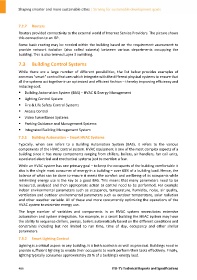Page 496 - Shaping smarter and more sustainable cities - Striving for sustainable development goals
P. 496
7.2.7 Routers
Routers provided connectivity to the external world of Internet Service Providers. The picture shows
this connection to an ISP.
Some basic routing may be needed within the building based on the requirement assessment to
provide network isolation (also called subnets) between various departments occupying the
building. This is also termed Layer 3 switching.
7.3 Building Control Systems
While there are a large number of different possibilities, the list below provides examples of
common "smart" control features which integrate with the different physical systems to ensure that
all the systems act together in an optimized and efficient fashion – thereby improving efficiency and
reducing cost.
Building Automation System (BAS) – HVAC & Energy Management
Lighting Control System
Fire & Life Safety Control Systems
Access Control
Video Surveillance Systems
Parking Guidance and Management Systems
Integrated Building Management System
7.3.1 Building Automation – Smart HVAC Systems
Typically, when one refers to a Building Automation System (BAS), it refers to the various
components of the HVAC control system. HVAC equipment is one of the most complex aspects of a
building since it has many components ranging from chillers, boilers, air handlers, fan coil units,
associated electrical and mechanical systems just to mention a few.
While an HVAC system has one primary goal – to keep the occupants of the building comfortable it
also is the single most consumer of energy in a building – over 60% of a building load. Hence, the
balance of what can be done to ensure it meets the comfort and wellbeing of its occupants while
minimizing energy use is the key to a good BAS. This means that many parameters need to be
measured, analysed and then appropriate action or control need to be performed. For example
indoor environmental parameters such as occupancy, temperature, humidity, noise, air quality,
ventilation and outdoor environmental parameters such as outdoor temperature, solar radiation
and other weather variable. All of these and more concurrently optimizing the operations of the
HVAC system to minimize energy use.
The large number of variables and components in an HVAC system necessitates extensive
automation and system integration. For example, in a smart building the HVAC system may have
the ability to sequence chillers, pumps, boilers automatically based on the different conditions and
constraints including but not limited to run time, time of day, occupancy and other similar
parameters.
7.3.2 Smart Lighting Control
Lighting is a critical aspect to any building. It is both aesthetic as well as practical. Buildings need to
provide sufficient lighting to enable their occupants to work perform their tasks effectively. Finally,
lighting typically consumes approximately 20 % of a building’s energy load.
486 ITU‐T's Technical Reports and Specifications

